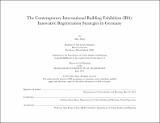| dc.contributor.advisor | Brent Ryan. | en_US |
| dc.contributor.author | Shay, Alice (Alice Ann) | en_US |
| dc.contributor.other | Massachusetts Institute of Technology. Dept. of Urban Studies and Planning. | en_US |
| dc.coverage.spatial | e-gx--- | en_US |
| dc.date.accessioned | 2012-10-10T14:54:52Z | |
| dc.date.available | 2012-10-10T14:54:52Z | |
| dc.date.copyright | 2012 | en_US |
| dc.date.issued | 2012 | en_US |
| dc.identifier.uri | http://hdl.handle.net/1721.1/73709 | |
| dc.description | Thesis (M.C.P.)--Massachusetts Institute of Technology, Dept. of Urban Studies and Planning, 2012. | en_US |
| dc.description | This electronic version was submitted by the student author. The certified thesis is available in the Institute Archives and Special Collections. | en_US |
| dc.description | Cataloged from student submitted PDF version of thesis. Pages [142] and [143] are blanks. | en_US |
| dc.description | Includes bibliographical references (p. 118-[123]). | en_US |
| dc.description.abstract | The Internationale Bauausstellung or International Building Exhibition (IBA) is a planning methodology implemented over the course of the 20th century and into the 21st century in Germany. The IBA is unique and characterized by a mix of seemly contradictory conditions. In composition, IBAs are characterized by being site- and time-specific by a mix of seemly contradictory conditions. In composition. IBAs are characterized by being site- and time-specific, long-term and temporary, driven by experimentation and independent in their urban development role. Conceptually, the IBA is driven by theoretical and practical experimentation and a goal to produce "models for the city of the future" that address paradigmatic shifts in urban development. After urban renewal, physical planning lost efficacy and the confidence for imaginative visions to be concretely brought to life. The IBA sits as an outlier in this commonly held conception of physical planning and urban design history. The IBA remains capable of large-scale transformations alongside careful experimentation that pushes existing thinking about the city forward. It is both conceptually ambitious and sensitively grounded in local regeneration. This study is focused on the meaning-making of the IBA-how it constructs new understandings of building: physical transformation and image-making for the city. Three contemporary IBAs were selected as cases to analyze the IBA methodology in its current implementation: 2010 IBA Saxony-Anhalt, 2013 IBA Hamburg and nascent 2020 IBA Berlin. In order to understand the dynamics of the IBA, this thesis is organized around three theoretical frames to analyze the IBA: city imaging, cultural regeneration and mega-events. Each of these frames deals with the complexity of building as an ideological act that shapes not only physical form but also the shape of the city in our minds. Based on analysis of the IBA, this thesis offers strategies for an approach towards the project of the city that can be as variegated as the urban context requires while maintaining the ambitions of urban design towards new models for the city of the future. towards new models for the city of the future. | en_US |
| dc.description.statementofresponsibility | by Alice Shay. | en_US |
| dc.format.extent | 141, [2] p. | en_US |
| dc.language.iso | eng | en_US |
| dc.publisher | Massachusetts Institute of Technology | en_US |
| dc.rights | M.I.T. theses are protected by
copyright. They may be viewed from this source for any purpose, but
reproduction or distribution in any format is prohibited without written
permission. See provided URL for inquiries about permission. | en_US |
| dc.rights.uri | http://dspace.mit.edu/handle/1721.1/7582 | en_US |
| dc.subject | Urban Studies and Planning. | en_US |
| dc.title | The contemporary International Building Exhibition (IBA) : innovative regeneration strategies in Germany | en_US |
| dc.title.alternative | Innovative regeneration strategies in Germany | en_US |
| dc.type | Thesis | en_US |
| dc.description.degree | M.C.P. | en_US |
| dc.contributor.department | Massachusetts Institute of Technology. Department of Urban Studies and Planning | |
| dc.identifier.oclc | 811398401 | en_US |
